

Subjects: Berthier Clip, APX, Adoption, Mle. 1902 and Mle. 1907, Mle. 07/15, the 1916 Modification, Mle. 07/15 m34, World War Two, Post War, Ownership.
| Article by Steve N. Jackson (v. 1) |
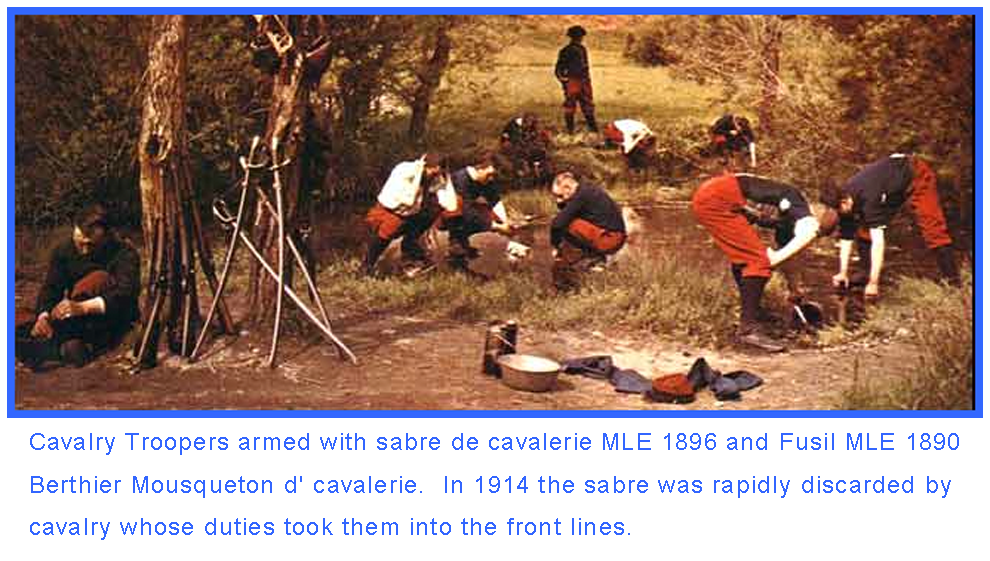 The French adoption of the Mle 1886 rifle and the 8mm Lebel cartridge was a revolutionary move in the development of small arms because of its ammunition, but the Mle 1886 itself had many drawbacks. It was slow to load, impossible to reload from horseback, complex to maintain, and expensive to manufacture. In addition, the short carbine version proved untenable. Its small magazine capacity was not seen as a drawback, but the cut-down tube magazine of prototype Mle 1886 was unreliable and efforts to improve it proved impossible (1).
The French adoption of the Mle 1886 rifle and the 8mm Lebel cartridge was a revolutionary move in the development of small arms because of its ammunition, but the Mle 1886 itself had many drawbacks. It was slow to load, impossible to reload from horseback, complex to maintain, and expensive to manufacture. In addition, the short carbine version proved untenable. Its small magazine capacity was not seen as a drawback, but the cut-down tube magazine of prototype Mle 1886 was unreliable and efforts to improve it proved impossible (1).
The shortcomings of the Mle 1886 were noticed almost as soon as it was issued, especially in the colonies. Mounted security forces, cavalry units, and artillery units were forced to use single shot Mle 1874 carbines, most not even converted to fire the modern 8mm Lebel ammunition. The limitation was a concern since the number of logistics and artillery units in the military were increasing but doctrine often put these units in close contact with the infantry where positional self-defence was a real possibility.
In 1887 L'Ecole Normale de Tir (ENT) and Manufacture d'armes de Châtellerault (MAC) began working to created a light carbine for the French army, but the work was considered of secondary importance as the French general staff had already decided to move forward with developing an autoloading rifle and a new ammunition to equip both infantry and support units. The armory efforts though failed to produce a suitable weapon and a new urgency was introduced into the problem when the Germans adopted the 1888 Commission rifle firing the new German 8x57mm cartridge. That commission rifle used a Mannlicher style stripper clip and was easily produced in carbine length for mounted soldiers.
The failure of the three shot version of the Mle 1886 and the ENT and MAC designs to show promise left a vacuum in the French military establishment. in late 1887 an employee of La Compagnie Bône-Guelm, a line of the Algerian unified railways (Bureau des Chemines de Fer Algérien), Adolph Berthier (2), began to look at designs being developed by American firearm inventor James Paris Lee and Austrian engineer Ferdinand Ritter von Mannlicher with an eye to creating a hybrid weapon for use by railway police and mounted colonial soldiers. Both designers had created weapons that used an en-bloc packet clip that held ammunition in bundles, allowing for rapid reloading of empty firearms. Lee was a champion of removable magazine rifles, but had developed packet clip designs when his magazine rifle was criticized for its costs. (3)
| Eventual Berthier Models in Service | |||||||
| Model | Cartridge | Length | Weight | Barrel | Magazine | ||
| Mousqueton d' cavalerie Mle 1890 | 8x50Rmm | 945mm | 3.02kg | 453mm | 3rd Mannlicher Type | ||
| Carabine d' gendarmerie Mle 1890 | 8x50Rmm | 945mm | 3.1kg | 453mm | 3rd Mannlicher Type | ||
| Carabine d' cuirassier Mle 1890. | 8x50Rmm | 945mm | 2.98kg | 453mm | 3rd Mannlicher Type | ||
| Mousqueton d'artillerie Mle 1892 | 8x50Rmm | 945mm | 3.02kg | 453mm | 3rd Mannlicher Type | ||
| Fusil Mle 1902 "Indochinese" | 8x50Rmm | 1126mm | 3.26kg | 633mm | 3rd Mannlicher Type | ||
| Fusil Mle 1907 "Senagalese" | 8x50Rmm | 1306mm | 3.82kg | 803mm | 3rd Mannlicher Type | ||
| Fusil Mle 1907/15 | 8x50Rmm | 1303mm | 3.79kg | 798mm | 3rd Mannlicher Type | ||
| Fusil Mle 1907/15 m16 | 8x50Rmm | 1303mm | 3.79kg | 798mm | 5rd Mannlicher Type | ||
| Mousqueton Mle 1892 m16 | 8x50Rmm | 945mm | 3.25kg | 453mm | 5rd Mannlicher Type | ||
| Fusil Mle 1907/15 m34 | 7.5x54mm | 1080mm | 3.68kg | 580mm | 5rd Mauser Type | ||
| Fusil Mle 1902 m37 | 7.5x54mm | 1075mm | 3.65kg | 570mm | 5rd Mauser Type | ||
| Top |
The Berthier clip itself was an innovation over the earlier Lee and Mannlicher designs. 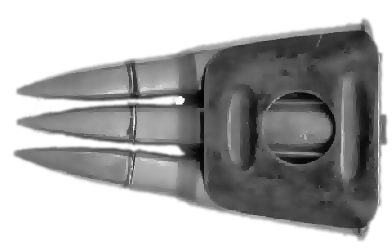 Mannlicher style clips used by the German Commission rifle were weak and tended to bend out of shape easily, while Mannlicher clips used in rifles such as the Steyr-Mannlicher M1895 were sometimes criticized as being expensive. To create a strong yet cheap clip Berthier chose an inexpensive spring-steel design (a similar tin design would also be chosen by John Garand in the United States M1 Rifle for the same reasons) that could be pressed in a single operation on a simple workshop press. The expense of magazines in the 1880s and 1890s had shot down the original Lee rifle design, and limited British soldiers to a single magazine for each of their rifles, so a cheap charger was essential for a weapon designed to be used in the colonies. The clips for the weapon cost less than half-a-penny each, a fact trumpeted in newspapers of the time, making each cost only a fraction of the ammunition that it contained, yet they were strong enough to be retained and reused if needed. Berthier simply married this magazine system to a modified, reduced-size Mle 1874 m80 receiver (4) and took much of his bolt design from the current Lebel Mle 1886.
Mannlicher style clips used by the German Commission rifle were weak and tended to bend out of shape easily, while Mannlicher clips used in rifles such as the Steyr-Mannlicher M1895 were sometimes criticized as being expensive. To create a strong yet cheap clip Berthier chose an inexpensive spring-steel design (a similar tin design would also be chosen by John Garand in the United States M1 Rifle for the same reasons) that could be pressed in a single operation on a simple workshop press. The expense of magazines in the 1880s and 1890s had shot down the original Lee rifle design, and limited British soldiers to a single magazine for each of their rifles, so a cheap charger was essential for a weapon designed to be used in the colonies. The clips for the weapon cost less than half-a-penny each, a fact trumpeted in newspapers of the time, making each cost only a fraction of the ammunition that it contained, yet they were strong enough to be retained and reused if needed. Berthier simply married this magazine system to a modified, reduced-size Mle 1874 m80 receiver (4) and took much of his bolt design from the current Lebel Mle 1886.
Below is a Berthier magazine with a loaded three-round clip (A), and one round expended from the clip (B). When the third round is chambered, the clip drops free from the bottom of the rifle.

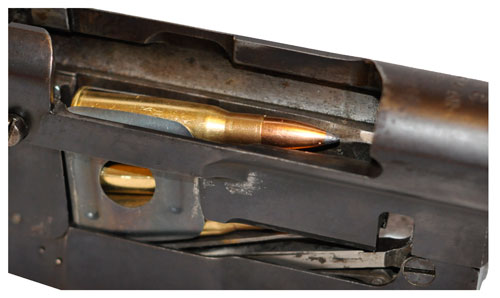 In 1888 Berthier began to work with L'Atelier de Puteaux (APX) to test and field his design in a way to mak it more acceptable to the French army. Berthier had a distinct advantage over many European designers because he was originally developing a weapon for the colonies, but this was a disadvantage for getting the weapon through the French military establishment. The French technical establishment was one of the best in Europe, competing toe to toe with the huge military industrial complex of Krupp in Germany, but it was essentially an organization designed to study problems - getting the problems dealt with had always been a hang up. In the French army innovation occurred when single-minded individuals were able to use the design power of the bureaux to push new concepts forward. No matter how strong a contender the Berthier was (and how dire the need), there still remained a task of convincing generals and politicians to fund its production.
In 1888 Berthier began to work with L'Atelier de Puteaux (APX) to test and field his design in a way to mak it more acceptable to the French army. Berthier had a distinct advantage over many European designers because he was originally developing a weapon for the colonies, but this was a disadvantage for getting the weapon through the French military establishment. The French technical establishment was one of the best in Europe, competing toe to toe with the huge military industrial complex of Krupp in Germany, but it was essentially an organization designed to study problems - getting the problems dealt with had always been a hang up. In the French army innovation occurred when single-minded individuals were able to use the design power of the bureaux to push new concepts forward. No matter how strong a contender the Berthier was (and how dire the need), there still remained a task of convincing generals and politicians to fund its production.
APX brought one additional item to the table. Berthier himself could hand-make a small number of weapons in his shops, but only APX could move the design to mass production.
A significant advantage of the Berthier design was that it was created to be simple to maintain with few complex parts. French soldiers in Europe were mostly literate, from communities where technology was found even in working class homes, and where conscript training was fairly well organized (5). Colonial soldiers were often illiterate, inexperienced with technology, and could well end up at the frontline with only one or two chances to use their weapons. Berthier started his weapon design with the assumption that it had to be as simple as possible, both to reduce cost (important in arming Colonial troops) and to make the weapon more reliable when operated by soldiers with less training(6). The Gras design had been so simple that it was nearly fool-proof. Colonial officers had found the Lebel to be complex and difficult to care for, although an excellent and mature design. The Berthier was a much simpler tool.
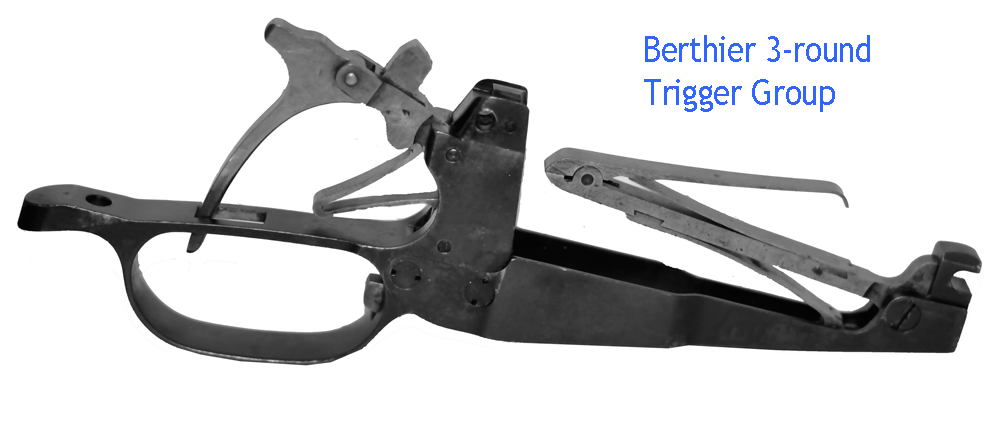
Adopting the Berthier to Service
 Despite Berthier's advantages or reliability and low cost, his design faced an uphill battle for adoption as he was a young outsider from the colonies competing with official designs (even if those designs were not bearing fruit). Berthier presented his early carbine to Comite de L'Artillerie and Section Technique de L'Armement in 1889 where it was rejected for service for what now seem like petty reasons. The Berthier, it turned out, has clips that could hang up in some instances when loading, requiring a minor modification to make them more streamlined. Despite the rejection Berthier went back to fix the clips and returned in a few weeks to present the carbine again, gaining acceptance in the first months of 1890.
Despite Berthier's advantages or reliability and low cost, his design faced an uphill battle for adoption as he was a young outsider from the colonies competing with official designs (even if those designs were not bearing fruit). Berthier presented his early carbine to Comite de L'Artillerie and Section Technique de L'Armement in 1889 where it was rejected for service for what now seem like petty reasons. The Berthier, it turned out, has clips that could hang up in some instances when loading, requiring a minor modification to make them more streamlined. Despite the rejection Berthier went back to fix the clips and returned in a few weeks to present the carbine again, gaining acceptance in the first months of 1890.
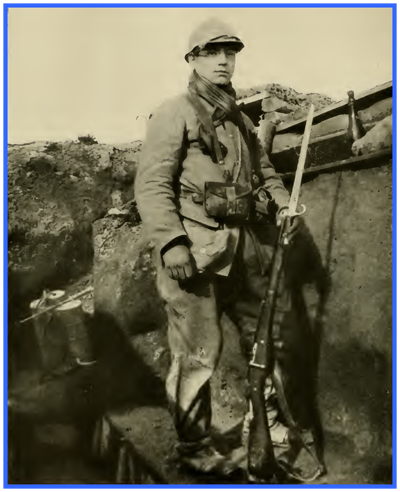 The Berthier carbine as adopted uses a simple bolt design similar to the earlier Mle 1886 but with a turned down bolt (straight bolts would later make an appearance with the Berthier rifle and would end up being found on carbines). The bolt locks into the receiver using two lugs and contains a firing pin with a main spring using a hammerless cocking piece. The bolt is disassembled by using a cartridge rim to remove a single screw, rotating the bolt head out of the bolt body. The cocking piece is then removed by pressing the firing pin against a hard surface and turning the bolt end knob, slipping it off the firing pin - similar to how the Mauser bolt is disassembled, although the Berthier bolt has fewer parts and was less expensive to make.
The Berthier carbine as adopted uses a simple bolt design similar to the earlier Mle 1886 but with a turned down bolt (straight bolts would later make an appearance with the Berthier rifle and would end up being found on carbines). The bolt locks into the receiver using two lugs and contains a firing pin with a main spring using a hammerless cocking piece. The bolt is disassembled by using a cartridge rim to remove a single screw, rotating the bolt head out of the bolt body. The cocking piece is then removed by pressing the firing pin against a hard surface and turning the bolt end knob, slipping it off the firing pin - similar to how the Mauser bolt is disassembled, although the Berthier bolt has fewer parts and was less expensive to make.
The Berthier trigger and magazine group was designed to sit entirely within the stock. Testing of the carbine had tried magazine capacities of 3 to 6 rounds but soldiers preferred the clean lines of the carbine with only three rounds (7). The result was a simple weapon that eliminated all small springs in favor if a simple bar design magazine. A loaded three round clip depresses the magazine element, which feed rounds into place for the bolt. When the last round is chambered the clip is then free to drop clear at the bottom of the weapon.
The original carbine and mousqueton designs had a one piece stock sometimes called a "pregnant guppy" design by modern owners. Six battle damaged Great War stocks in the author's collection all are made from oak but other woods were used during the weapon's long production history. The stocks were held in place by a screw and two barrel bands.
The Mle 1890 and 1892 lacked a mechanical safety, as most French rifles and carbines would until the adoption of the Mle 1940. French policy called for soldiers to carry a loaded rifle without a round in the chamber, only chambering the first round when ordered to by an officer or NCO. The theory was that a rifle with no round in the chamber could never go off, unlike a rifle whose safety failed, or whose safety was improperly employed.
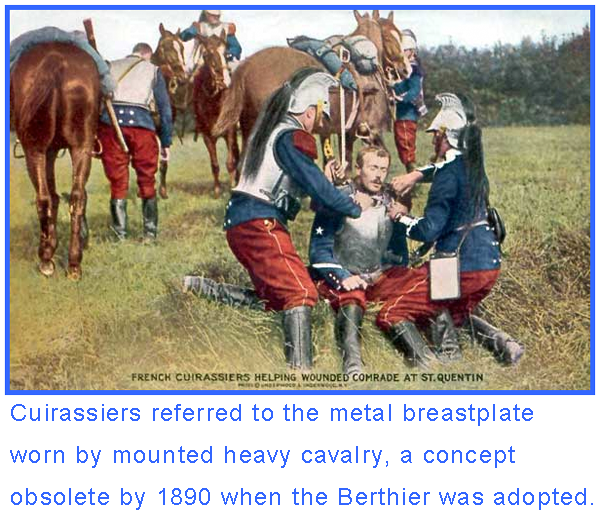 The original Mle 1890 design was created in three slightly different versions: the cuirassier, the cavalry, and the gendarmie. Each model had interchangeable bolts and trigger mechanisms and differed only in the arrangement of the sling, stock, and secondary hardware. Soldiers were issued ammunition in 6 round paper packets loaded in clips and ready to fire. Ammunition loads varied, but most soldiers carried 72 rounds before the Great War as a basic load. During the Great War the official issued was increased to 120 rounds, but soldiers often found ways to carry even more ammunition.
The original Mle 1890 design was created in three slightly different versions: the cuirassier, the cavalry, and the gendarmie. Each model had interchangeable bolts and trigger mechanisms and differed only in the arrangement of the sling, stock, and secondary hardware. Soldiers were issued ammunition in 6 round paper packets loaded in clips and ready to fire. Ammunition loads varied, but most soldiers carried 72 rounds before the Great War as a basic load. During the Great War the official issued was increased to 120 rounds, but soldiers often found ways to carry even more ammunition.
The cuirassier model was unusual in that its stock had a leather butt plate and was designed to be used with the steel breast plates still used by the Cuirassier cavalry. These weapons were supplemented by an artillery version in 1892. For practical purposes all of the versions of the Berthier became muddled as time went on as modifications were made to all four models. These modifications would continue for as long as the carbines remained in service but were often applied unevenly - weapons can be found with a wide range of sling attachments, sights, stock arrangements, and stacking hardware.
The Berthier carbines were issued with a new Bayonet, the Mle 1892 pattern. This bayonet was knife design different than the epee carried by the Mle 1874 and the Mle 1886, with a single true edge and a handle that would allow it to be used as a utility knife.
| Top |
 The Fusil Mle 1902 and 1907 Rifles
The Fusil Mle 1902 and 1907 Rifles
In 1901 French colonial authorities in Indochina requested a rifle to replace the Fusil Gras Mle 1874 and other black powder fired rifles then in inventory. At the time production of the Mle 1886 was being wound down in favor of a new automatic rifle that it was hoped would reach service by 1913. The Mle 1886 in any case was not preferred in the colonies. The Navy had been issuing an earlier version of this rifle, the Mle 1875 in 11x59Rmm for more than 25 years, and it had proven itself overly complex in actual service off-ship. The Mle 1886 was a well made weapon with a strong mechanism, but it required a great deal of effort to care for, and in the colonies rust and wear could make the rifles unserviceable in a short while. It was also expensive, and the French government had never been known for spending money on colonial military forces that could be avoided.
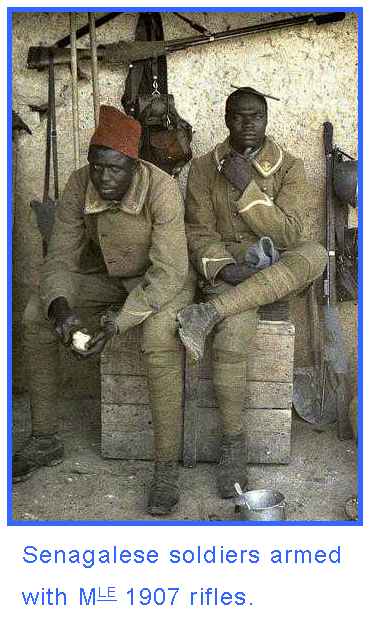 With the entire military awaiting the appearance of an automatic rifle and unwilling to purchase a weapon that would soon be obsolete, it appeared that the colonies would have to look to rechambered Mle 1874 rifles until a better solution was found. The natural choice for a new rifle was to create a lengthened version of the Mle 1892. Sample weapons already existed, having been tested in 1889. The Berthier metal work was already in production, allowing small lots of rifles to be ordered without extreme expense. The result of was the Fusil Mle 1902 "Indochinese." Around 30,000 of these weapons would be made and issued to Annamese units. These rifles are notable for their shorter length barrels and handy intermediate size. They were equipped with turned down bolts, volley sights (although they were dangerous to use in actual battalion volley fire) and infantry piling hooks.
With the entire military awaiting the appearance of an automatic rifle and unwilling to purchase a weapon that would soon be obsolete, it appeared that the colonies would have to look to rechambered Mle 1874 rifles until a better solution was found. The natural choice for a new rifle was to create a lengthened version of the Mle 1892. Sample weapons already existed, having been tested in 1889. The Berthier metal work was already in production, allowing small lots of rifles to be ordered without extreme expense. The result of was the Fusil Mle 1902 "Indochinese." Around 30,000 of these weapons would be made and issued to Annamese units. These rifles are notable for their shorter length barrels and handy intermediate size. They were equipped with turned down bolts, volley sights (although they were dangerous to use in actual battalion volley fire) and infantry piling hooks.
The success of the Mle 1902 lead to the Mle 1907 for the Senagalese tirailleurs. This rifle returned to the standard 800mm rifle barrel of the Mle 1886 m93 and was also equipped with a straight bolt. The 1907 was made in batches to equip newly mustered in units, and gradually replaced the Fusil Gras Mle 1874.
In April 1917 20 battalions of Senagalese tirailleurs were thrown into battle around Chemin des Dames during 2nd Aisne. These units went into battle under-equipped, under poor leadership, following the tactics of General Nivelle. Their Fusil Mle 1907 proved a disappointment in battle - the officers of the colonial tirailleurs paid little attention to keeping the Senagalese rifles in working order, often considering these weapons merely a convenient place to hang a bayonet. As a result the rifles, despite their rugged simplicity, failed en-masse during the battle. Even when the soldiers could keep their weapons in action they were only issued 40 clips of ammunition for each attack, with new ammunition rarely reaching the attacking soldiers before they were cut down.
Stocks of Mle 1907 were in hand as late as 1940 and the Mle 1902 had a proposed conversion to 7.5x54mm that was never put into front-line service.
| Top |
The Standardized Berthier
A great deal of ink has been spilled by historians trying to explain the inexplicable events at the start of the First World War. In fact, the first six months of the war and the later stalemate in the trenches, and of interest for this article the creation of the Fusil Mle 07/15, are all easiest to explain by looking at the intentions of the Allies and the Central Powers without the confusion created by the propaganda of the "miracle on the Marne" and other stories.
Both the Germans and the French had a clear mobilization and attack plan in case of war that concentrated on what each power would do to achieve a rapid negotiated victory while virtually ignoring the realistic capabilities and plans of the other side. The French Plan XVII called for a sudden strike into Alsace and Lorraine, capturing these former French possessions and moving into the industrial Ruhr Valley. Once fortified in the Ruhr the French planned to dictate terms to the decapitated Germany. The French saw the plan taking at most six months, and had enough ammunition and weapons to fight this long. The main French mistakes included overestimating the effectiveness of their artillery versus the better German weapons, completely failing to understand the German willingness to turn their flank through Belgium, and completely ignoring the hard won tactical experience that the French Army had gained overseas during the decade before the war.
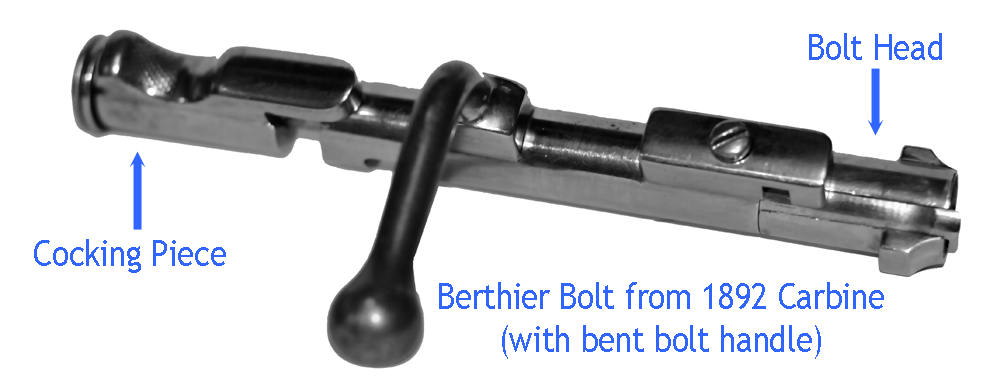 The German Schlieffen Plan has long been sold by historians as the great gamble to sunder the French that almost worked but for a few divisions of jaunty poilu riding Paris taxi cabs. In fact the Germans never intended to do more than take the industrial north of France while destroying its armies in the field so that it could dictate terms. Like the French the Germans had neither the supplies nor the infrastructure to support a long war - their ammunition supplies were estimated to be good for around six months with no clear program in place to increase production in the near future. The main weakness of the German plan was the assumption that the Belgium Army would offer minimal resistance in their passage through that country, that the French would fold when their industrial north was occupied, and the belief that they could destroy the French flanks in Lorraine and the Belgium frontiers.
The German Schlieffen Plan has long been sold by historians as the great gamble to sunder the French that almost worked but for a few divisions of jaunty poilu riding Paris taxi cabs. In fact the Germans never intended to do more than take the industrial north of France while destroying its armies in the field so that it could dictate terms. Like the French the Germans had neither the supplies nor the infrastructure to support a long war - their ammunition supplies were estimated to be good for around six months with no clear program in place to increase production in the near future. The main weakness of the German plan was the assumption that the Belgium Army would offer minimal resistance in their passage through that country, that the French would fold when their industrial north was occupied, and the belief that they could destroy the French flanks in Lorraine and the Belgium frontiers.
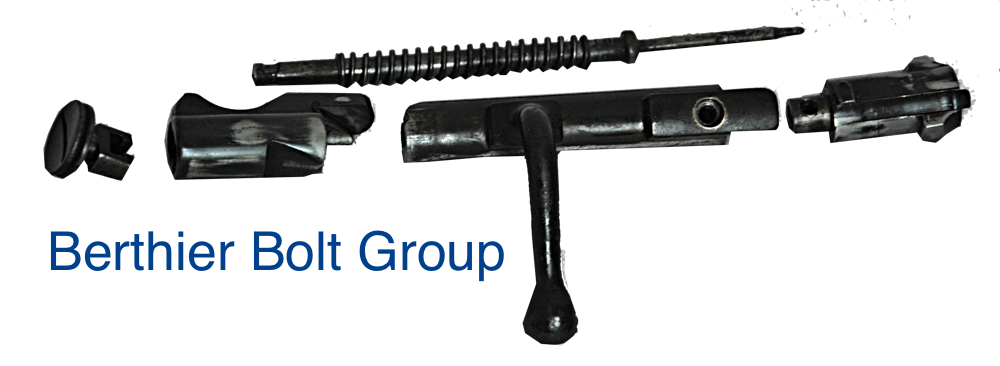
The mistakes at the start of the Great War caught all of the combatants with too few weapons to arm the rapidly expanding armies. The trench lines that formed after December 1914 required huge numbers of infantry. France in particular suffered for lack of modern arms - not only was her army larger than the rest of the allies, but she had been in the process of seeking a semi-automatic rifle to replace its obsolete Mle 1886/93 Lebels. Lebel production had not been ramped up before the war because the weapon was expensive to produce and no clear successor was ready that could be adopted without changing the entire logistic structure of the French armed forced; it was simply too late in 1914 to adopt a new rifle ammunition and the politics of the French army prevented earlier adoption.
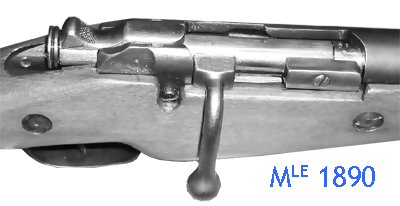 After the initial fighting on the French frontier settled down, French colonial soldiers from Algeria, Senegal, and Indochina began arriving on the western front in regimental strength carrying Berthier Mle. 1890, 1892, 1902, and 1907 rifles and carbines. The basic Berthier design had several key advantages over the Lebel: it was quicker to load in the confines of a trench system, it was cheaper to produce in quantity and faster to make, and it was easier to clean and maintain. In addition the 1907 was actually in production - French arsenals would produce small runs of the weapon as they were needed by Senegalese Tirailleur units. As a result a slightly modified Mle. 1907 was chosen as the Mle 1907/15, becoming the alternate standard rifle of the French military.
After the initial fighting on the French frontier settled down, French colonial soldiers from Algeria, Senegal, and Indochina began arriving on the western front in regimental strength carrying Berthier Mle. 1890, 1892, 1902, and 1907 rifles and carbines. The basic Berthier design had several key advantages over the Lebel: it was quicker to load in the confines of a trench system, it was cheaper to produce in quantity and faster to make, and it was easier to clean and maintain. In addition the 1907 was actually in production - French arsenals would produce small runs of the weapon as they were needed by Senegalese Tirailleur units. As a result a slightly modified Mle. 1907 was chosen as the Mle 1907/15, becoming the alternate standard rifle of the French military.
Although an excellent design, the Mle 1907/15 was in many ways anarchistic. The rifle was nearly 1.3 meters long in keeping with the obsolete theory of volley fire. It was equipped with better sights than the Lebel but had a significant disadvantage when employed using new French infiltration tactics of only having a three round clip. It also had an open bottom action to allow the packet clip to drop free of the when the last round was chambered. This opening was a good design feature in a cavalry weapon in the era before machine guns but allowed an unacceptable amount of dirt and mud to enter the weapons magazine well in trench warfare. These design flaws were well understood even when the weapon was adopted, but the speed of its standardization meant they could not be immediately dealt with. Instead they were corrected when the weapons were returned to the armory by applying the 1916 modifications.
 The Mle 1907/15 was produced at Manufacture d'armes de Saint-Étienne, Manufacture d'armes de Châtellerault, Etts Continsouza, Automobiles Delaunay-Belleville, and the Remington Arms Corporation. Manufacture of the rifle was relatively easy, but the American firm Remington Arms Corporation had difficulty converting the metric mechanical processes to English units, and the entire American production run of nearly 100,000 rifles was rejected.
The Mle 1907/15 was produced at Manufacture d'armes de Saint-Étienne, Manufacture d'armes de Châtellerault, Etts Continsouza, Automobiles Delaunay-Belleville, and the Remington Arms Corporation. Manufacture of the rifle was relatively easy, but the American firm Remington Arms Corporation had difficulty converting the metric mechanical processes to English units, and the entire American production run of nearly 100,000 rifles was rejected.
| Top |
The 1916 Modifications
The French Modification 1916 for the Mle 1892 carbine and Mle 1907/15 rifle are usually assumed by firearm historians to be simply a means of providing high ammunition capacity to French soldiers who were suffering from the Berthier’s limit of 3 rounds, but the story of the adoption of the model 1916 is, like many little understood aspects of French firearm manufacture the story is actually more complex.
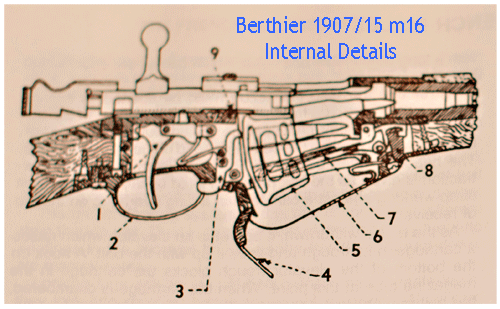 The French Army after its defeat in the war of 1870 - 1871 became determined to seek a method of improving the nation’s military capabilities against their newly arisen foes, the united Germans empire. The loss of Alsace and Lorraine (and indeed, the feelings of the residents of these areas that they were now subjects of what they considered a foreign power) and the huge repatriations forced on France nearly assured that a future war would be inevitable. This was despite the misgivings of Otto von Bismarck, Chancellor of Germany, who felt that Germany would not be able to survive more than one generation past his death if it did not find some way to make a lasting peace with France (admittedly, Bismarck would likely be equally willing to to achieve peace by the dismemberment of France as by compromise).
The French Army after its defeat in the war of 1870 - 1871 became determined to seek a method of improving the nation’s military capabilities against their newly arisen foes, the united Germans empire. The loss of Alsace and Lorraine (and indeed, the feelings of the residents of these areas that they were now subjects of what they considered a foreign power) and the huge repatriations forced on France nearly assured that a future war would be inevitable. This was despite the misgivings of Otto von Bismarck, Chancellor of Germany, who felt that Germany would not be able to survive more than one generation past his death if it did not find some way to make a lasting peace with France (admittedly, Bismarck would likely be equally willing to to achieve peace by the dismemberment of France as by compromise).
| 1. Trigger | 2. Trigger Guard | 3. Clip Catch | 4. Magazine Plate | 5. Packet Clip |
| 6. Magazine Bottom | 7. Follower | 8. Follower Support | 9. Ejector |
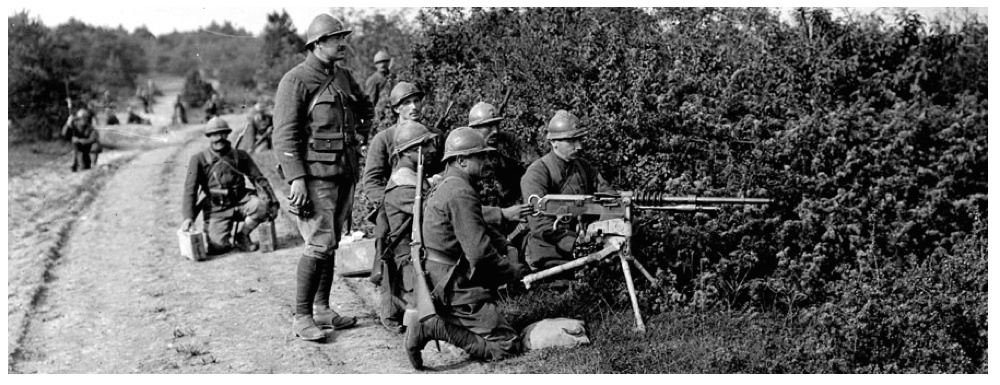
During the war of 1870 - 1871 the French defeat had been authored by dissolute strategy, by the huge German conscript army, and by the firepower of the Krupp produced steel, breech-loading cannons. Thus the French general staff came away from the war believing that:
1) the French army needed to be numerically superior to the German army (even at the expense of other qualities).
2) The French army needed to produce and field new military technologies rapidly enough to maintain a crucial technological advantage, resulting in greater firepower compared to the German opposition.
and
3) The French army needed to install and maintain offensively spirited generals who would not fall into the malaise that the generals of Napoleon III had.
The problem with the plans France had was that although it wanted a modern army, it lacked a modern financial infrastructure that would allow it to build and sustain the army. After 1865 France adopted the Latin Monetary Unit based franc causing regular financial disruptions that even colonial profits could not coverup. Likewise the regressive tax structure exempted the wealthiest members of society, limiting the ability of France to collect taxes on the level of Germany without ruining the economy. On paper France’s economy was more than capable of maintaining a military force greater than Germany, but politicly it was hamstrung.
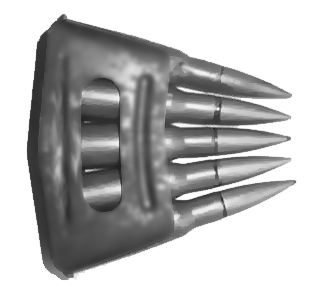 A further issue was the trend in the Army caused by the split between the firepower and the élan vital branches of the military(8), a conflict born by economic limitations. The firepower branch believed that France should field a smaller army but equip it with heavy artillery, planes (new to the military but with recognized utility), machine guns, and an autoloading rifle, and that for longer wars conscription could always be used to fill the ranks of the army - while military alliances with England and Russia would further aid France in time of war. This group also believed that training should rounded out to include attack and defense, with investment into heavy artillery and machine guns being an effective way of blunting enemy superiority in numbers. This group did not reject having large numbers of soldiers in uniform, but did not want to spend money on soldiers that could not be armed even if they could be trained.
A further issue was the trend in the Army caused by the split between the firepower and the élan vital branches of the military(8), a conflict born by economic limitations. The firepower branch believed that France should field a smaller army but equip it with heavy artillery, planes (new to the military but with recognized utility), machine guns, and an autoloading rifle, and that for longer wars conscription could always be used to fill the ranks of the army - while military alliances with England and Russia would further aid France in time of war. This group also believed that training should rounded out to include attack and defense, with investment into heavy artillery and machine guns being an effective way of blunting enemy superiority in numbers. This group did not reject having large numbers of soldiers in uniform, but did not want to spend money on soldiers that could not be armed even if they could be trained.
The élan vital faction of the army did not reject technology, in fact its greatest proponent Joseph Joffre was willing to spend money on equipment, although heavy artillery, machine guns, and planes where not much to his liking they were not rejected outright. The élan vital party felt that victory on the battlefield went to the side who had the highest morale and willingness to attack at any cost. Equipment, training, firepower, and even the study of tactics and strategy was less important than the pure will to attack. This strategy though required a large number of men to make work, and had the potential to generate huge casualty lists. Americans following the same strategy were handed surprising setbacks when attacking entrenched Spanish on San Juan Hill (and proved ultimately successful due to the training of the cavalry regiments who used fire and maneuver to take their objectives) while the British lost a series of battles during the Boer war, include a sharp defeat at the Battle of Magersfontein with more than a thousand casualties when trying to press for a victory using their own version of élan vital.

When Joffre took over as commander of the French Army the efforts of the military to adopt a new semi-automatic rifle and heavier artillery took a back seat to élan vital. Joffre did improve training, but most of this training was not very realistic to a modern conflict and did not take advantage of the considerable tactical experience gained by the French in Algeria and Indochina. The primary maneuver of the army was the formation charge (the French were not alone in ignoring pervious experience from the colonies in Europe, the British would keep this tactic in their playbook long after even the French had abandoned it after suffering huge casualties in the Flanders in 1916 and 1917 with only the ANZAC units shaking loose from its seductive hold).
The formation charge as a tactic was one reason the French did not adopt a new semi-automatic rifle or invest heavily in machine guns, both of which were advocated by firepower enthusiasts. It also assured that any alternate weapon would not be adopted by the French Army in time for hostilities, the élan vital faction considered a rifle as simply a convenient place to hang a bayonet.
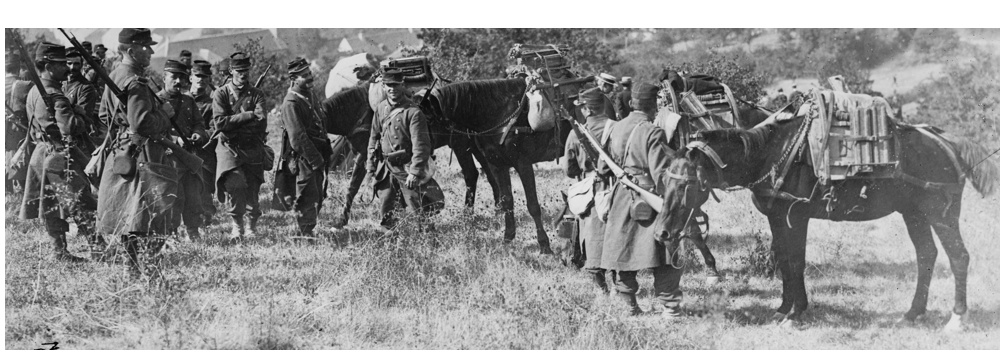
At the start of the Great War the French tactics of élan vital created a blood bath. Ill-equipped soldiers poorly trained for modern war wearing highly visible uniforms and backed by artillery that was too light for its purpose resulted in over a quarter of a million casualties in the first thirty days alone. The Germans, content to allow the French to attack with little tactical sense, spent the next year simply sitting back on gained ground, counting on Joffre to win the war for them.
While Joffre was busy killing French soldiers for no gain in an effort to prove élan vital, an obscure and nearly retired colonel and advocate of firepower, Philippe Pétain, began his slow rise to fame. Pétain early in the war recognized that German artillery and machine guns provided them a crucial advantage while they were on the defensive - as they would likely be for the rest of the war in their current positions. He also recognized that if France was required to take each meter of ground with ten lives lost (or worse, gain no ground for thousands of dead) as the élan vital ideal was proving to cost, then France would run out of soldiers long before Germany was pushed even to the borders of 1914.
 Pétain instead developed a combination of tactics and equipment and employed them in spite of their contravention of the doctrine set out by the French military hierarchy, and the tactics were successful enough that it caused the French army to change its entire equipment procurement by war’s end. The system Pétain developed started with short, concentrated artillery barrages (often fired without registration) followed by a tactical advance featuring small units (the rifle section). This section was armed with carbines, marksman carried rifles, light machine guns, and grenades for maximum portable firepower, and were trained to make maximum use of cover. Each unit would move across no-man’s land in short rushes, until machine gun positions could be assaulted at around 200 meters distance by sniper, rifle grenade, and light machine gun fire. Unlike the normal French and British system of the time Pétain’s system also required that gains be consolidated as soon as they were made - normal French and British standards had successful attacks followed by further attacks until all attacker strength was wasted and gains could not be kept. In Petain's system the soldiers who gained a trench dug-in and prepared for defense and reinforcement, only taking up a new attack when the older one was protected.
Pétain instead developed a combination of tactics and equipment and employed them in spite of their contravention of the doctrine set out by the French military hierarchy, and the tactics were successful enough that it caused the French army to change its entire equipment procurement by war’s end. The system Pétain developed started with short, concentrated artillery barrages (often fired without registration) followed by a tactical advance featuring small units (the rifle section). This section was armed with carbines, marksman carried rifles, light machine guns, and grenades for maximum portable firepower, and were trained to make maximum use of cover. Each unit would move across no-man’s land in short rushes, until machine gun positions could be assaulted at around 200 meters distance by sniper, rifle grenade, and light machine gun fire. Unlike the normal French and British system of the time Pétain’s system also required that gains be consolidated as soon as they were made - normal French and British standards had successful attacks followed by further attacks until all attacker strength was wasted and gains could not be kept. In Petain's system the soldiers who gained a trench dug-in and prepared for defense and reinforcement, only taking up a new attack when the older one was protected.
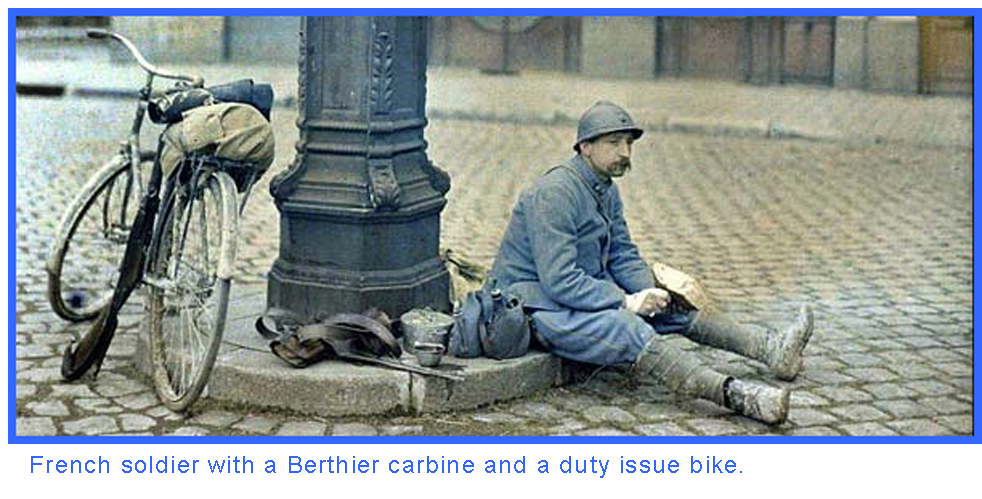
With these tactics perfected Pétain and the Army command sought out new weapons that would support them. New recoil carriage heavy artillery with high angle firing capability increased the effectiveness of French artillery (9), while French sections were rapidly equipped with new light automatic weapons (10), a semi-automatic rifle (issued to non-commissioned officers) (11), a scope mounted marksman rifles (12), and rifle grenades (13). Pétain could not, until he was given overall command, force these arrangements on the entire army (and indeed, when he was in overall command he was still under control of Foch - whose tactical and strategic faults are legendary, but who was an excellent political general). His changes though did not go unnoticed, and he was able to push through a series of new weapons in 1915, and change tactics for units in his area of control.
| 1916 Modification Program |
The 1916 modification of the Berthier carbine and rifle was the final part of the Pétain strategy, born more from a lack of any other way to get a simple, clip fed rifle into the hands of soldiers. The weapon used the same bolt, barrel, and stock of the Mle 1892 carbine and Mle 1907/15 rifle, but added two key changes - a five round magazine capacity (14) and a gate on the magazine drop to keep dirt out of the action. The m16 rifles and carbines were popular with soldiers, and provided a useful grenade launching platform as well as a standard infantry rifle.
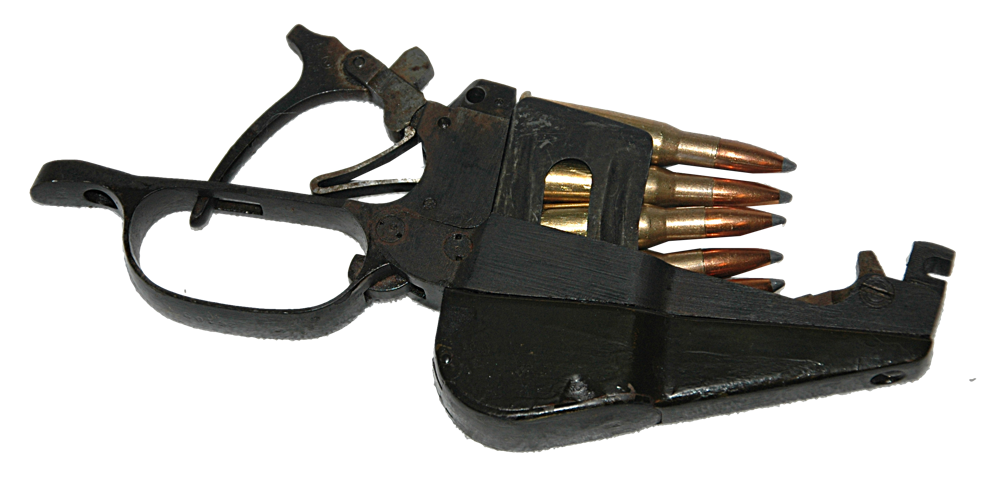

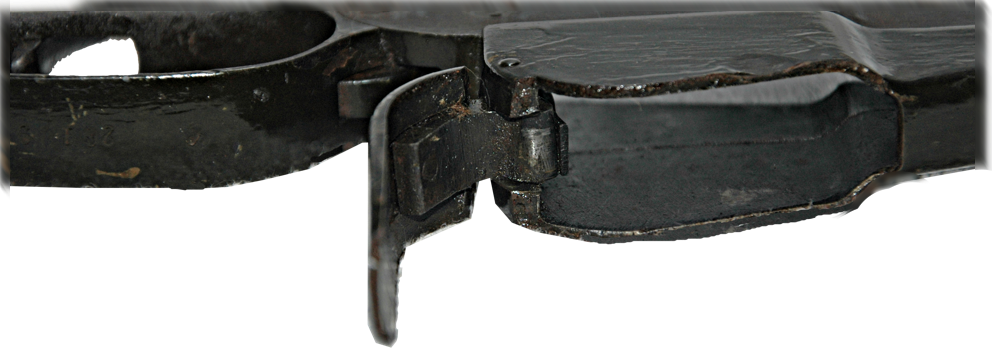
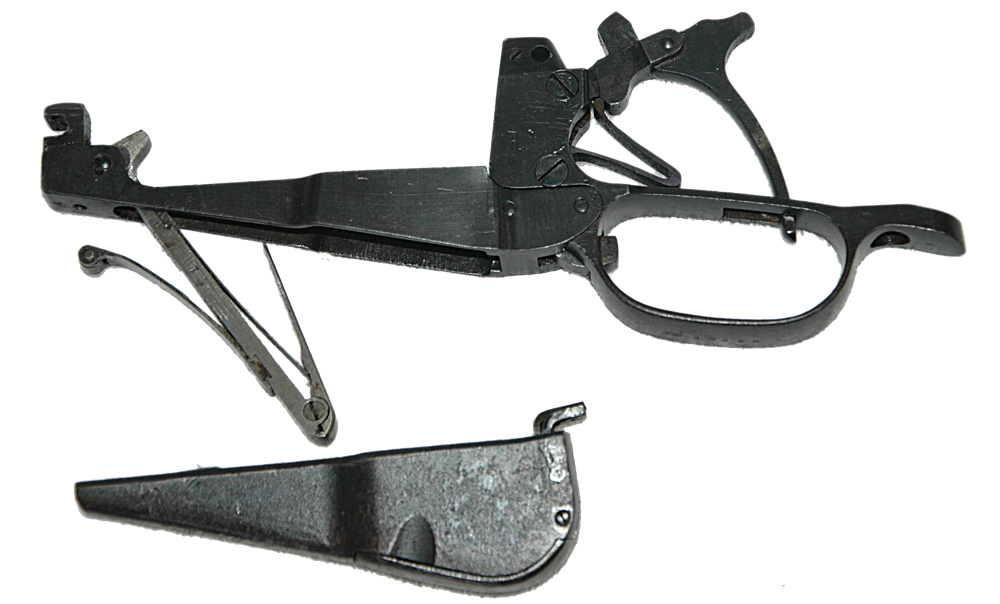
| Top |
After the Great War
With the end of the war the French army was left with millions of weapons, a clear tactical understanding of how to employ infantry in a modern war, a strong junior officer corps, a nearly worthless senior officers corps, and a strong armory system with a first rate engineering staff. One bright spot in small arms development for the French was the recognition that volley fire was a dead letter as a military tactic. Rifles with 800mm barrels were rapidly retired and sent to arsenals. Production continued after the war of the Berthier Mle 1892 m16 carbines (which would continue its manufacturing run until 1938), but all other Berthier designs were discontinued.
After the war tens of thousands of Berthier rifles and carbine made their way into the hands of Polish Blue Army equipping nearly the entire Polish I and III Corps. Likewise 10,000 Berthier Mle 1907/15 m16 rifles and Mle 1892 m16 carbines were transferred to the Greek Army by French forces stationed in the Peloponnesian isthmus, with most of the rifles being converted to carbine during the 1920s.
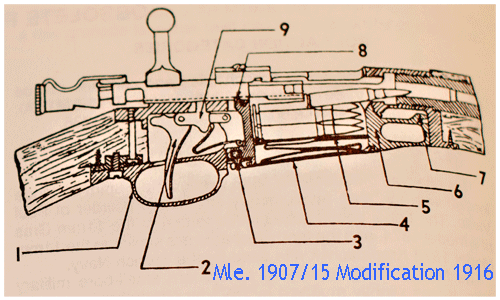 In 1921 the Army developed a plan to replace all small arms in service with weapons that better fit the Army tactics developed in great war. This would include a new semi-automatic pistol, a new light mortar, a light machine gun to replace the Mle 1915 CSRG, a repeating (bolt action) rifle for second-line use, and a semi-automatic rifle for front-line use. The key at the center of this plan was adoption of a new rimless ammunition. This ammunition was first released for the Fusil mitrailleur Mle 1924 in 7.5x57mm, which was modified in 1929 to 7.5x54mm which went into wide spread production as the standard French small arms ammunition. Despite its adoption millions of rifles existed in storage or in frontline units that fired 8x50Rmm ammunition, a reserve that was too valuable to simply discard, so efforts were started to develop a Berthier carbine conversion for the Mle 1907/15.
In 1921 the Army developed a plan to replace all small arms in service with weapons that better fit the Army tactics developed in great war. This would include a new semi-automatic pistol, a new light mortar, a light machine gun to replace the Mle 1915 CSRG, a repeating (bolt action) rifle for second-line use, and a semi-automatic rifle for front-line use. The key at the center of this plan was adoption of a new rimless ammunition. This ammunition was first released for the Fusil mitrailleur Mle 1924 in 7.5x57mm, which was modified in 1929 to 7.5x54mm which went into wide spread production as the standard French small arms ammunition. Despite its adoption millions of rifles existed in storage or in frontline units that fired 8x50Rmm ammunition, a reserve that was too valuable to simply discard, so efforts were started to develop a Berthier carbine conversion for the Mle 1907/15.
| 1. Trigger Guard | 2. Trigger | 3. Magazine Plate Lock | 4. Bottom Plate | 5. Follower |
| 6. Magazine Wall | 7. Forward Magazine Block | 8. Ejector | 9. Sear |
The Berthier Mle 1907/15 modification 1934
This was a short rifle with a barrel length in between a carbine and the old long rifle re-chambered for 7.5x54mm.  In place of the Lee-Mannlicher ammunition packet the rifle took the Mauser mechanism closely copied from the 1908 Mauser. The conversion of the bolt was simply achieved by replacing the bolt head. Ironically, the Mle 1907/15 modification 1934 was not as cheap a conversion as expected - only the rear bolt, receiver, and the trigger mechanism of the previous weapon could be retained from the original weapons. The only advantage with the conversion is that it reduced the number of machine tools needed to produce the weapon. Around 80,000 of these weapons were on hand by 1939
In place of the Lee-Mannlicher ammunition packet the rifle took the Mauser mechanism closely copied from the 1908 Mauser. The conversion of the bolt was simply achieved by replacing the bolt head. Ironically, the Mle 1907/15 modification 1934 was not as cheap a conversion as expected - only the rear bolt, receiver, and the trigger mechanism of the previous weapon could be retained from the original weapons. The only advantage with the conversion is that it reduced the number of machine tools needed to produce the weapon. Around 80,000 of these weapons were on hand by 1939
Hundreds of thousands of Berthiers of all marks were in French service at the start of World War Two, and many of these were captured and integrated into second line German units. While nearly every model entered German service, some coming from multiple sources (Polish, Greek, Yugoslavian, and French), seven models in particular were used in quantity, equipping entire units of German soldiers, especially those in France.
Karabiner 551(f) - Mousqueton Mle 1890
Karabiner 552(f) - Mousqueton Mle 1892
Karabiner 553(f) - Mousqueton Mle 1892 m16
Gewehr 302(f) - Fusil Mle 07/15
Gewehr 304(f) - Fusil Mle 07/15 m16
Gewehr 241(f) - Fusil Mle 07/15 m34
Karabiner 502(g) - Mousqueton Mle 1892 (captured from the Greeks)
German units along the Atlantic wall, especially those tasked with artillery and machine gun emplacement, were issued the Berthier, nearly 100,000 were in hand after the surrender of France in 1940, because of the low probability these units were going to engage in regular infantry type actions. There are many surviving archival images of French rifles of all types in German hands on Atlantic Wall, but none to the knowledge of the author from service in Russia or Italy. It would seem that the local supply of ammunition was the main reason these weapons were issued. France at its fall had millions of rounds of 8mm Lebel and 7.5x54mm in hands, enough to supply an Army of 500,000 for 60 war days. With that army disbanded these stocks of ammunition represented a valuable resources to the weapon and ammunition hungry German military. Most units equipped with these weapons were not expected to survive their first encounters with the military, and when stocks were expended, especially of the 8mm Lebel, there would be no need to make any more (although Vichy and then occupied France did make considerable amounts of 7.5x54mm ammunition for the German war effort).
Berthiers also served widely with the French colonial forces. After the fall of France French units were divided between those who clung to the allies (the Free French) and those with nominal Vichy loyalty. Vichy units had a difficult supply situation as shipping hulls in the Mediterranean, Indian Ocean, and the Far East were either commandeered by the allies, commandeered by the Axis, or interred at neutral ports. Vichy units never had the foriegn ammunition manufacture capacity to support their overseas units. Free French units though, when they did not simply re-equip with American hardware after her entry into the war, had access to ammunition in both 8mm Lebel and 7.5x54mm made by American corporations and paid for by Lend Lease. Divisions raised in North Africa in particular retained a large number of Berthier carbines and fought with them in Italy (in small numbers) and Southern France.
| Top |
In 1948 the Berthier rifle was given another chance to service. At that time Orman ve Su İşleri Bakanlığı (the Turkish Ministry of Forest and Water Management) was becoming concerned that illegal logging was threatening a range of rare and valuable trees in the Turkish forest lands. Turkey is widely forested. Nearly 30% of the country is covered by woodlands, nearly all of it owned directly by the Turkish government. One of the most valuable trees in the forests, and a source of considerable income for the government, is the Circassian Walnut. Poachers of these trees were becoming increasingly bold, and were a threat to the 5,000 rangers tasked with protecting the forest.

The Turkish looked for a simple weapon to arm the rangers with better than the odd lots of revolvers they carried, and came up with a unique weapon, a rebuilt Berthier. At the time, the Turkish government had tens of thousands of Berthiers on hand. They had been captured in WW1, purchased in the interwar years, intercepted in WW2, and in some cases were recieved as gifts from the Germans over the years. Backing these arms up were literally millions of rounds of unwanted 8x50mmR ammunition from a wide range of sources.
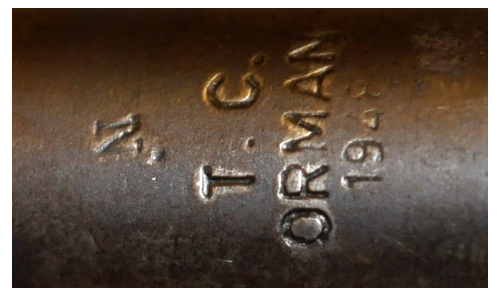 These weapons had several distinct advantages. They were rugged - Turkish rangers were (and remain) a group that mostly operates without vehicles. The Berthiers were far more rugged than the more elegant and fragile Mauser 1903 and 1905 rifles in reserve inventory. The Berthiers were not able to challenge the real military if they fell into rebel hands - revolutionaries would not start seeking out Rangers for their weapons (Turkish police stations were often targeted by rebel forces seeking weapons). Finally, the 8x50mmR was rare in civilian hands and not commonly available on the black market. With no ready source of ammunition even if the rifle fell into the wrong hands it was unlikely it would be very useful. A final factor was that the rifle was distinctive. A stolen Berthier would cause attention the way other weapons would not.
These weapons had several distinct advantages. They were rugged - Turkish rangers were (and remain) a group that mostly operates without vehicles. The Berthiers were far more rugged than the more elegant and fragile Mauser 1903 and 1905 rifles in reserve inventory. The Berthiers were not able to challenge the real military if they fell into rebel hands - revolutionaries would not start seeking out Rangers for their weapons (Turkish police stations were often targeted by rebel forces seeking weapons). Finally, the 8x50mmR was rare in civilian hands and not commonly available on the black market. With no ready source of ammunition even if the rifle fell into the wrong hands it was unlikely it would be very useful. A final factor was that the rifle was distinctive. A stolen Berthier would cause attention the way other weapons would not.
The Turkish government in 1948 took from 3,000 to 10,000 weapons from storage. The weapons were chosen for having the best mechanical actions, barrels, and surface condition, then were refurbished. Their barrels were either replaced, or if good condition rifle barrels, shortened to 50 cm length. The stocks for Berthier rifles were cut down, then fitted with new hardware including a barrel shroud over the chamber. The carbines were then marked "TC Orman 1948" (Turkish Forest Service) (15) and issued to the Ranger service. The weapon was taken from service in the 1980s and sold to the United States en masse, where they developed a small following because of their excellent quality, cheap price, and handy size for use as a hunting or scout rifle. The end of commercial loading of the 8x50mmR and the rarity of its clips has reduced interest in this rifle, although barreled receivers make excellent project guns for people who worry about ruining a historical Berthier.

After the war French Berthiers were rapidly transferred to Gendarmerie arsenals. These rifles were no longer used as long-arms (the Gendarmerie was officially equipped with the Mle 1936 for this purpose) but was instead issued for use in riot control as the equivilant of a club. The last Gendarmerie Berthiers were finally retired in 1999 and replaced with wooden batons, with large stocks of the rifles being sold to the United States.
The Berthier carbine was first manufactured in 1890, and continued to be built through 1938 - an incredible 48 year production run (16). The main cause of the Berthier's longevity was its reliability under the worst conditions and ease of repair. Berthier rifles were one of the most common weapons traded in African and Middle Eastern arms markets until the wave of Russian weaponry hit in the early 1960s. Berthier rifles were in the hands of several Arab forces during the Arab Israeli war of 1948 (where they faced yet again the K98 rifle in the hands of the Hagganah), and early African guerrilla movements, most notably Algeria, were equipped with these weapons, often captured from police station. Most Arab national forces dropped these weapons in the 1950s, and the weapon is only occasionally found on international arms markets because of the rarity of the ammunition.
| Top |
Owning the Berthier Rifle and Carbine
The Berthier rifle and carbine were produced for 50 years, and for the first forty years the main design did not change. Below is a Mle 1892 carbine produced in 1893 (A - the lack of a rear pin drop shows it was made before 1909), the Mle 1907 rifle produced in 1912 (B), the Mle 07/15 rifle produced in 1917 (C), the Mle 1892 m16 produced in 1928 (D), and the Mle 1892 rifle carbine produced in 1917 and converted to a Turkish Forestry carbine in 1948 (E). All of these rifles and carbines can generally interchange their receivers and bolts. Only the Mle 1907/15 m34 and Mle 1902 m37 Berthiers departed from the main design making their parts incapable of interchange with older weapons.
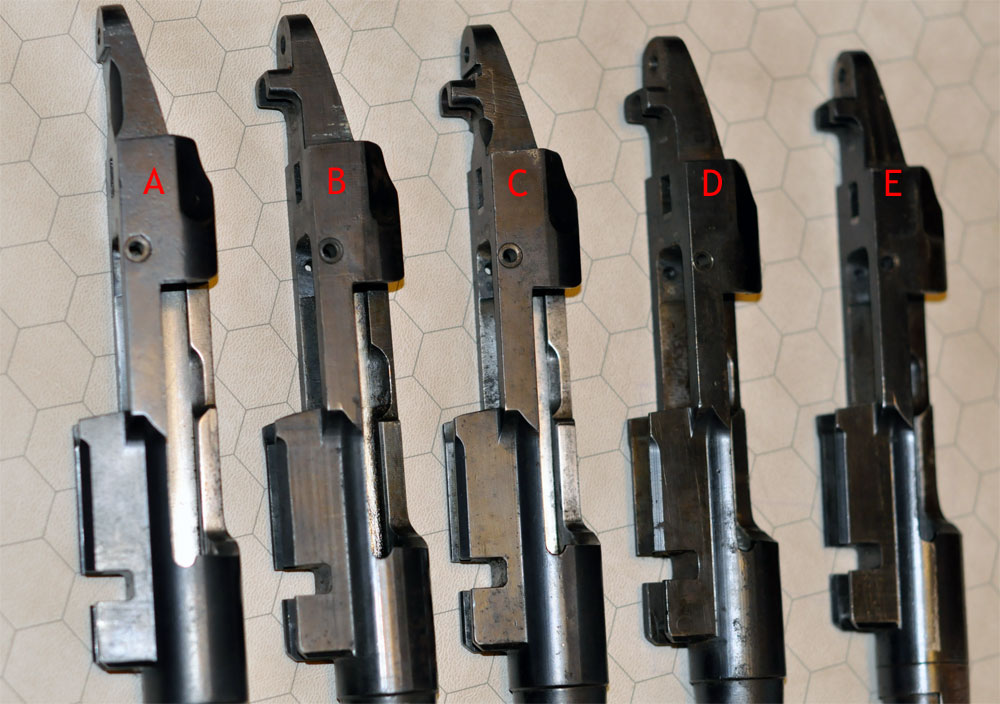
The emergency of the First World War and the long production history of the Berthier rifle has resulted in a chaotic situation for the modern Berthier owner. Armorers in the Great War would receive damaged weapons, pull parts from different weapons, and send the new weapon out to the front as soon as possible. The result has been that few Berthiers have matching numbers or even parts made in the same century. The author has seen a carbine receiver made in 1893 combined with a rifle bolt from 1917, a magazine and trigger mechanism made for a rifle in 1916, and a barrel made in 1928, combined with a stock and hardware from a weapon produced in the 1920s.
Berthier rifles entered the United States in three significant batches. First, United States soldiers returned from World War One with Berthier rifles they had been issued, and from World War Two with captured weapons liberated from German soldiers in France. These rifles where usually stolen as French weapons captured by the allies or issued to US soldiers in the Great War were suppose to be returned to French armories, and thus will not have clear paper describing their origins. A second source of French rifles was the 1950s when long arms of various models were declared surplus and sold off to arms houses in the United States. These weapons could be bought for $5 mail order or in rifle bins, and were often sporterized in a rough manner. A final batch of weapons entered the United States in the 1990s when French arsenals cleaned shop of the nearly 500,000 long guns they had in storage. Weapons from these final two eras are typically roller marked by their importer, in keeping with U.S. import laws.
French Berthier rifles and carbines in the United States should all be tested by a competent gunsmith. Only rifles marked with an "N" mark on both the receiver and the barrel should be fired with modern ammunition. Many captured WW1 weapons will never have been updated - a process that occurred in the 1930s to allow 8mm ammunition designed for machine guns to be used in ordinary rifles.

This rifle is marked with the Balle N, meaning that it was tested and updated to use the most modern version of the 8x50R Lebel. These rifles, if otherwise properly head-spaced and sound, can fire modern production 8mm Lebel ammunition if they are in good condition.
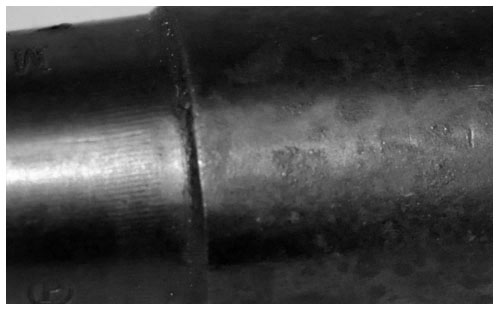 The lack of markings on the barrel and receiver of a Berthier, except for the Mle 34 (chambered for 7.5x54mm) and the Turkish Forestry Carbine (whose barrel shroud and new manufacture 1948 barrel covered up the older markings) indicates a rifle that was never converted for the Balle N. It is extremely dangerous to fire these weapons using modern ammunition, and even low power reloaded ammunition should be attempted only after a complete checkout by a competent gunsmith.
The lack of markings on the barrel and receiver of a Berthier, except for the Mle 34 (chambered for 7.5x54mm) and the Turkish Forestry Carbine (whose barrel shroud and new manufacture 1948 barrel covered up the older markings) indicates a rifle that was never converted for the Balle N. It is extremely dangerous to fire these weapons using modern ammunition, and even low power reloaded ammunition should be attempted only after a complete checkout by a competent gunsmith.
Historic weapons without the Balle N markings can still be valuable historical weapons. Since most Berthiers have had many lives and been rebuilt for use in two or even three conflicts the historic value of a weapon that remains in its original Great War configuration is considerable, even if it is no longer able to be shot.
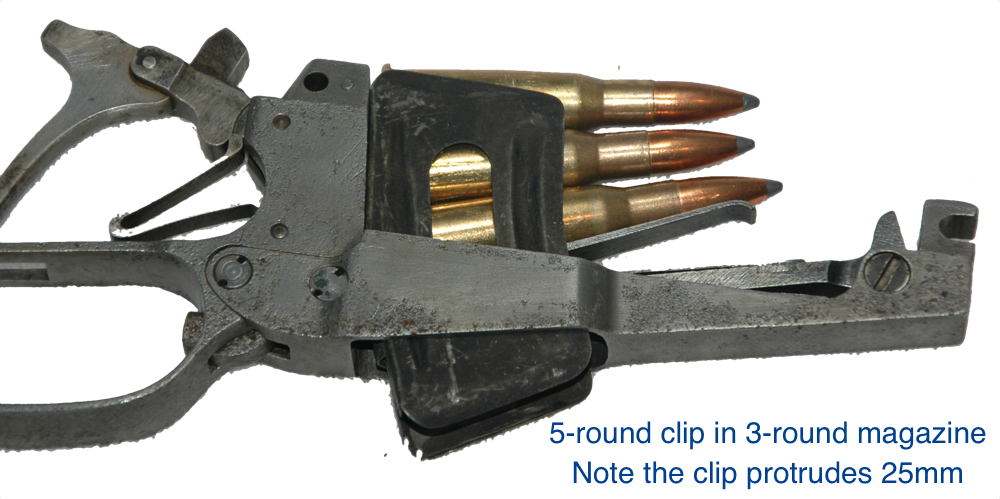
Owners of Berthiers equipped with 3-round packet clips have a different issue - the "disposable" 3-round clip has not been commercially produced by France since 1920 except for a small production run for Turkey in the 1940s. New clips available today are mostly from small production runs by enthusiasts, often costing more than 30 $USD.
Two problems face owners of Berthier rifles and carbines in the modern era - the lack of a full spare parts inventory for them, and the lack of any good source of historically accurate stocks and stock parts. Currently a new, modern barrel for the Berthier will cost around $250. Some spare parts are available, but the wide range of parts once available have now dried up. A dedicated Berthier lover will start out with a barreled receiver, most of which have long histories, or even with a receiver sans barrel (especially if the weapon is intended for firing and not just use in reenactments). The Berthier parts themselves are simple for experienced machine shop workers to make, but require a skilled gunsmith to assure they meet tolerances. In most cases the Berthier rebuilder faces a problem that local gunsmiths lack the skills to do an entire rebuild, mostly being trained to assemble rifles from parts, not hand make new parts in a shop. If you do find someone with the skills, then keep a hold of them - they are part of a dying breed.
Stock making is likewise problematic. Most stock foundries cannot cut stocks to the Berthier size as their CNC machines do not have the specifications, and stock duplication often means destroying a stock to make a stock, hardly a solution. Again, finding a top flight stock maker is the key to the process.
| Top |
| Notes: |
(1) The Mle 1886/93 was eventually turned into a carbine in the Mle 1886/93 r35. (return)
(2) There is significant confusion in the literature between Louis "Emile" Berthier, the miltary engineer, and Adolph Berthier, the designer. Most documents refer to the inventor of the Berthier rifle as Adolph, one of the designers that worked on the Berthier-Vickers machine gun.(return)
(3) The British adopted the Lee magazine for the Lee Metford and Lee Enfield rifles. Although Lee was an advocate of the large magazine capacity and rapid reloading afforded by the removable magazine, the British appreciated the removable magazine because it allowed easy cleaning of the mechanism. The main British objection to issuing more than one magazine to each soldier was not their failure to recognize their utility but because of concerns of cost.(return)
(4) All French repeating (bolt action) rifles from 1866 to 1936, a period of nearly 70 years, used very similar receivers, trigger groups, and bolts, modified in small ways for each new model of weapon. Thus the Mle 1866 needed only part of its bolt replaced and some modifications to the barrel's chamber to turn it into an Mle 1874. The Berthier bolt has a better extractor than the Mle 1874 m80 and locks into the receiver at the bolt handle, but is otherwise very similar. The receivers themselves differ mostly cosmetically, except for modifications to allow for a stronger lock required for shooting smokeless powders. This can be seen in the image below where (A) is a Mle 1874 m80 and (B) is a Mle 1892 m16.
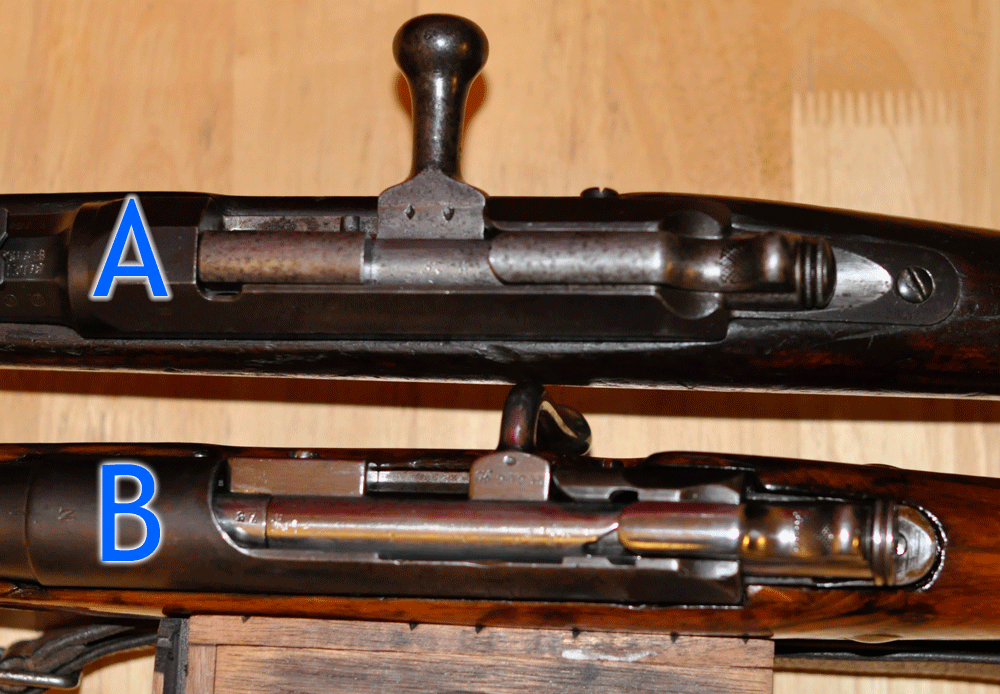
(5)Even European training standards were deficient by the norms of later generations. Readers of Erich Maria Remarque's "All Quiet on the Western Front" showed how even the excellent German Army just barely trained its soldiers before sending them to frontline units. Active French colonial units developed fighting skills over decades, but reserve units simply existed on paper to save money. Most would be formed, armed, and learn their weapons en route to their assigned places on the front. (return)
(6) New York Times, December 13th, 1891.(return)
(7)Testing weapon designs by handing the weapons to troops did not always come up with answers that would stand up to combat. Soldiers in the 1889 tests preferred weapons that were easy to use in the field - external magazines tended to catch on uniforms and clothes and be harder to shoulder in route marches. By the Great War the Berthier design was seen as superior to the Mle 1886/93 except for its 3 round magazine capacity, resulting in the development and fielding of the Modifié 16 for the Berthier series with a 5 round magazine. (return)
(8)Discussions of these cliques often call them them the offensive faction of generals (what I call the élan vital clique) and the defensive faction of generals, as indeed at the time generals such as Joffre used the term “defensively minded” to indicate an inferior general (one who did not agree with them). In fact, the two sides were different, but it did not rest on the issue of defense and attack. The the élan vital clique felt even teaching soldiers about entrenching, firepower, and cover tactics would drain their will to fight, a theory that had existed since the adoption of smoothbores. To some extent these generals actually welcomed casualties as proof of their own superior performance, and believed that failure to take objectives (any objectives) was a result of the lack of will on the part of the basic soldier. The defensive clique, which is better called the "firepower" clique, did not exclusively believe in defensive operations, merely that troops should be taught to sustain a tactical defensive that allowed firepower to chip away at the enemy until they could no longer attack, then to attack only when a clear advantage was present. The best way to sum up the groups: élan vital believed in attacking always and using attrition of soldiers to achieve goals, while the firepower clique believed in material attrition to protect manpower strength with training for both attack and defense. (return)
(9)The Canon de 105 Mle 1913 (Schneider) had been rejected by the French general staff under Joffre not because of its expense, but because it was seen as less martial than the lightweight Canon de 75 Mle. 1897 (which was light enough to follow advancing infantry close); the perception was that it was a “defensive” or siege weapon. The Mle 1897 was an excellent canon; it was suitable for fast moving colonial use like no other artillery piece made in previous 50 years, but it was primarily a direct fire canon with a high muzzle velocity and relatively small explosive charge. It was also ineffective against even shallow trenches. As it was the French would fight well past 1917 at a significant disadvantage in terms of artillery. (return)
(10)The Fusil mitrailleur Mle 1915 (CSRG) “Chauchat” is perhaps one of the least understood weapons of the modern era, and one of the most unfairly maligned. Poor quality control and a faulty conversion from metric to english units of measurement put a barely functional .30 calibre version of the weapon into American hands which has ever since tainted its name. In reality the weapon (as shown by its post war use by several nations) and modern test firing of the weapon shows it was of equal reliability to later portable machine guns, especially when provided with an enclosed magazine. The Chauchat was an important part of French strategy as it was light enough for an infantryman to carry it and a useful amount of ammunition across no man’s land, wit fired from an inline stock (making it very controllable under automatic fire) and had a very slow cyclic fire rate. It’s replacement post war had less to do with perceived faults in the design and more to do with a desire to drop the obsolete 8mm Lebel cartridge from military service. Another advantage for the Chauchat: it’s introduction was supported from an early date by Joffre, who considered it a more “offensive” weapon than the heavy machine gun. (return)
(11)The French possessed a handful of the innovative Menuier rifle in the early years of the war, this rifle being the design that was intended before the war to equip the entire army, then adopted the Mle 1917 for front line units. A final design, the Mle 1918, appeared too late to be of much use in the Great War, (return)
(12)The French army was not unique in using scoped rifles, nearly every army had them. It was unique in the issue of these weapons to assault squads rather than only to special hunter teams. French snipers would direct accurate fire at machine gun barrels and the crews that served them to suppress them so the rest of the squad could move position. France was one of the first nations to design its standard battle rifle (the MAS 1949) with an integral mount for scopes.) Despite the French emphasis on small unit use of snipers and widespread issuing of scopes the “best” sniper of the war was actually Canadian, Corporal Francis Pegahmagabow, with 378 confirmed German kills.(return)
(13)The French used grenades, and especially rifle grenades such as the VB grenade, as their standard counter machine gun weapon. This started as an attempt to address a serious allied deficiency in light mortars. Grenade launching became so important to the French that by the 1950s they adopted a rifle (the 1949/56) that gave every infantry soldier the ability to launch these weapons. The French rifle section of 1917 had nearly every soldier not carrying a Chauchat essentially designated as a grenadier or a sniper. (return)
(14)The Berthier was tested in 1889 with a wide range of magazine capacities from three to six rounds. The three round capacity was chosen after testing by soldiers - it was handier, did not catch on clothing, and it was still faster to shoot than the Mle 1886. When the weapon was used for cavalry or for volley shooting the three round capacity was sufficient, but in no-man’s land the smaller magazine capacity was a real detriment. A five round magazine put it on par with the Mauser 98 rifles in use by the German infantry. (return)
(15) Many sources state incorrectly that TC Orman was a French company that refurbished the weapons for sale to Turkey. While it is possible the weapons came from France or were even refurbished there, the word Orman is Turkish for Forest. (return)
(16) The basic AK-47 and M-16 have each remained in production more than 50 years while remaining issued to front-line soldiers - while the German K98 likewise was in service for half a century. In the history of arms manufacture most weapon designs stay in service for a hundred or more years. This changed in the 1860s but seems to be returning as a norm - there is every sign the AK-47 and its close relatives will be in service in the 2050s, 100 years after its first release. (return)
| Top |
| Citations |
_. (1918). From the First Shot: A pictorial history of the Great War. Independent / Library of Congress.
Bayonets: An Illustrated History
An Illustrated Companion to the First World War
Pershing - The Soldiers' General
Small arms of the world: A basic manual of small arms
Small Arms Of The World: The Basic Manual Of Military Small Arms
Gunes, Y. and Elvan, O. (2005). The Underlying Causes Of Illegal Logging Activities In Turkey. FAO.
Greenhill Military Small Arms Databook
Collecting Classic Bolt Action Military Rifles
Allied Rifle Contracts in America - Mosin-Nagant, Mauser, Enfield, Berthier, Remington, Savage, Winc